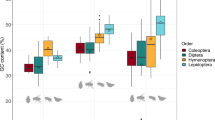Summary
Several forms of maximum likelihood models are applied to aligned amino acid sequence data coded for in the mitochondrial DNA of six species (chicken, frog, human, bovine, mouse, and rat). These models range in form from relatively simple models of the type currently used for inferring phylogenetic tree structure to models more complex than those that have been used previously. No major discrepancies between the optimal trees inferred by any of these methods are found, but there are huge differences in adequacy of fit. A very significant finding is that the fit of any of these models is vastly improved by allowing a certain proportion of the amino acid sites to be invariant. An even more important, although disquieting, finding is that none of these models fits well, as judged by standard statistical criteria. The primary reason for this is that amino acid sites undergo substitution according to a process that is very heterogeneous. Because most phylogenetic inference is accomplished by choosing the optimal tree under the assumption that a homogeneous process is acting on the sites, the potential invalidity of some such conclusions is raised by this article's results. The seriousness of this problem depends upon the robustness of the phylogenetic inferential procedure to departures from the underlying model.
Similar content being viewed by others
References
Adachi J, Hasegawa M (1992) Amino acid substitution of proteins coded for in mitochondrial DNA during mammalian evolution. Jpn J Genet (in press)
Anderson S, Bankier AT, Barrell BG, de Brujin MHL, Coulson AR, Drouin J, Eperon IC, Nierlich DP, Roe BA, Sanger F, Schreier PH, Smith ALH, Staden R, Young IG (1981) Sequence and organization of the human mitochondrial genome. Nature 290:457–464
Anderson S, de Brujin MHL, Coulson AR, Eperon IC, Sanger F, Young IG (1982) The complete sequence of bovine mito-chondrial DNA: conserved features of the mammalian mitochondrial genome. J Mol Biol 156:683–717
Barry D, Hartigan JA (1987) Statistical analysis of hominoid molecular evolution. Stat Sci 2:191–210
Bibb MJ, Van Etten CT, Wright CT, Walberg MW, Clayton DA (1981) Sequence and gene organization of mouse mitchondrial DNA. Cell 26:167–180
Bishop MJ, Friday AE (1985) Evolutionary trees from nucleic acid and protein sequences. Proc R Soc Lond B 226:271–302
Dayhoff MO, Schwartz RM, Orcutt BC (1978) A model of evolutionary change in proteins. In: Dayhoff MO (ed) Atlas of protein sequence structure, vol 5, suppl 3. National Biomedical Research Foundation, Washington DC, pp 345–352
Desjardins P, Morais S (1990) Sequence and organization of the chicken mitochondrial genome: a novel gene order in higher vertebrates. J Mol Biol 212:599–634
Felsenstein J (1981) Evolutioanry trees from DNA sequences: a maximum likelihood approach. J Mol Evol 17:368–376
Gadaleta G, Pepe G, DeCandia G, Quagliariello C, Sbisa E, Saccone C (1989) The complete nucleotide sequence of the Rattus norvegicus mitochondrial genome: cryptic signals revealed by comparative analysis between vertebrates. J Mol Evol 28:497–516
Gillespie JH (1986) Variability of evolutionary rates of DNA. Genetics 113:1077–1091
Hasegawa M, Horai S (1991) Time of the deepest root for polymorphism in human mitochondrial DNA. J Mol Evol 32:37–42
Hasegawa M, Kishino H (1989) Heterogeneity of tempo and mode of mitochondrial DNA evolution among mammalian orders. Jpn J Genet 64:243–258
Hasegawa M, Kishino H, Yano T (1985) Dating of the human-ape splitting by a molecular clock of mitochondrial DNA. J Mol Evol 22:160–174
Kishino H, Hasegawa M (1989) Evaluation of the maximum likelihood estimate of the evolutionary tree topologies from DNA sequence data, and the branching order in Hominoidea. J Mol Evol 29:170–179
Kishino H, Miyata T, Hasegawa M (1990) Maximum likelihood inference of protein phylogeny and the origin of chloroplasts. J Mol Evol 31:151–160
Nei M (1987) Molecular evolutionary genetics. Columbia University Press, New York, chapter 11
Roe BA, Ma DP, Wilson RK, Wong JFH (1985) The complete nucleotide sequence of the Xenopus laevis mitochondrial genome. J Biol Chem 260:9759–9774
Sakamoto Y, Ishiguro M, Kitagawa G (1986) Akaike information criterion statistics. Reidel, Tokyo, chapter 4
Wilbur WJ (1985) On the PAM matrix model of protein evolution. Mol Biol Evol 2:434–447
Author information
Authors and Affiliations
Rights and permissions
About this article
Cite this article
Reeves, J.H. Heterogeneity in the substitution process of amino acid sites of proteins coded for by mitochondrial DNA. J Mol Evol 35, 17–31 (1992). https://doi.org/10.1007/BF00160257
Received:
Accepted:
Issue Date:
DOI: https://doi.org/10.1007/BF00160257




